Happy Friday! Today on Museum Bites we’re sampling antique locks. These whimsical beauties are not only pretty, they did their part to protect the valuables behind them. Join me for a brief look at three clever locks I’ve come across in my travels. We begin in Amsterdam…
If I had the gift of tongue, I would declare and do no wrong.
Who you are that come by stealth, to impair my Master’s wealth.
~Johannes Wilkes, Detector Lock (c1675-1700) inscription
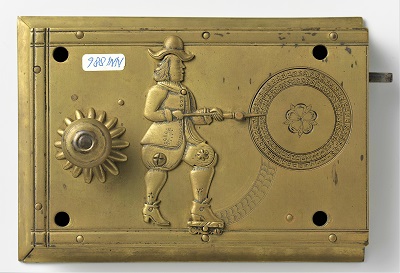
High Kicks: Our first lock is on display at the Rijksmuseum. Designed and crafted by Johannes Wilkes, the Detector Lock (c1675-1700) is made of iron and brass and loaded with security features. First, the keyhole is hidden. Press the button beneath the man’s left shoe and he’ll execute an impressive high kick and grant access to the keyhole. Once the key is inserted, the operator can lock or unlock not one, but two deadbolts. An additional turn of the key causes the primary deadbolt to extend even further. Wilkes also added keyless exit and entry. Just press the back brim of the man’s hat to lock or unlock the secondary bolt, no key necessary. For the truly paranoid owner, the double-dial on the right records the number of entries. Hence the name Detector Lock. Once the dial reaches 100, the lock will not release unless it is reset—turn the key while pushing the button located at the tip of the man’s shirt collar.
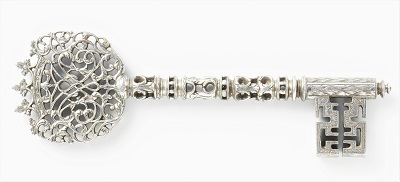
According to the Rijksmuseum, the original owner had the Detector Lock installed on an interior door to a room that contained his valuables. If you’d like to see this ingenious lock in action, and I highly recommend that you do, click on this Detector Lock video link courtesy of YouTube.
Fairytale: Our next lock features characters from the popular folktale, Snow White and the Seven Dwarfs. Made of iron with bronze, copper, gold and silver inlay, this enchanting gizmo was crafted by Frank L. Koralewsky (1872-1941) and is on display at the Art Institute of Chicago.
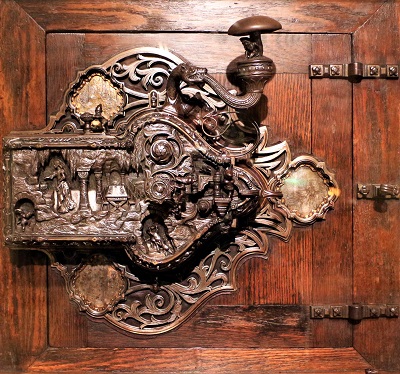
Zoom in to see Snow White cooking over an open fire with six of the dwarfs in various activities. Dwarf #1 and #2 are carrying food (i.e., carrot and rabbit) up to the kitchen. Dwarf #3 and #4 tend the fire, while #5 turns a knob above Snow White. Dwarf #6 is fast asleep under a toadstool…perhaps this is Sleepy?! And Dwarf #7 is perched atop the corresponding key, which unfortunately is not on display. On the far right is an etching of the wicked Queen and her infamous mirror, mirror on the wall.
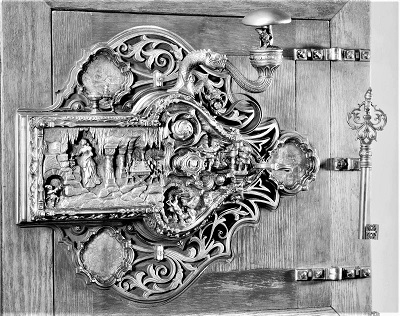
It took seven years for Koralewsky to complete this enchanting lock. His efforts were rewarded when it won a gold medal at the 1915 Panama-Pacific International Exposition.
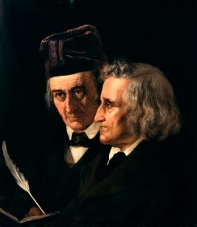
Fun Fairytale Fact: Brothers Jacob and Wilhelm Grimm (1785-1863 & 1786-1859) were librarians, who collected and wrote down the oral folktales of their fellow Germans, including Snow White and the Seven Dwarfs. Seven editions of their Grimm’s Fairytales were published between 1812 and 1857. The original versions were too grim (pun intended!) for children, but later editions were modified and thus more palatable.
Wine Cache: Our final lock hails from France and is also on display at the Art Institute of Chicago. Crafted from steel and finely detailed, this delightful lock and key were made sometime between 1675 and 1700. Known for their bold and cutting edge designs, 17th-century French ironworkers handcrafted exquisite “door furniture” including bolts, escutcheons, keys, knockers, and locks.

The ornate key brings to mind an extravagant toothbrush and no doubt added some heft to the owner’s pocket. The lock resembles a miniature façade. Flanked by intricate vines and ionic columns, the keyhole, like the Detector Lock can be hidden, in this case behind an arched doorway. Above the entrance, a friendly face gazes down with the letters VIN etched beneath. Perhaps this lock secured a stash of wine (vin means wine in French). Regardless of its purpose, this door furniture is a charming example of functional art.
Fun Furniture Fact: An escutcheon is a flat and often ornamental piece of metal that surrounds a door handle, keyhole or light switch.
That concludes our brief look at locks and keys. Next week, I’ll be back with more Museum Bites. In the meantime, have a fun and festive week!
 Cover photo by Kerstin Riemer, courtesy of Pixabay.
Cover photo by Kerstin Riemer, courtesy of Pixabay.
Sources:
Art Institute of Chicago: Collection Spotlight by Katie Rahn
Art Institute of Chicago: Snow White and the Seven Dwarfs Lock
National Endowment for the Humanities: Grimm Brothers

What a delightful topic. Locks as a… Who knew? I especially liked the fairytale lock but the first one from the museum in Amsterdam was amazing. Such cleverness!
LikeLiked by 1 person